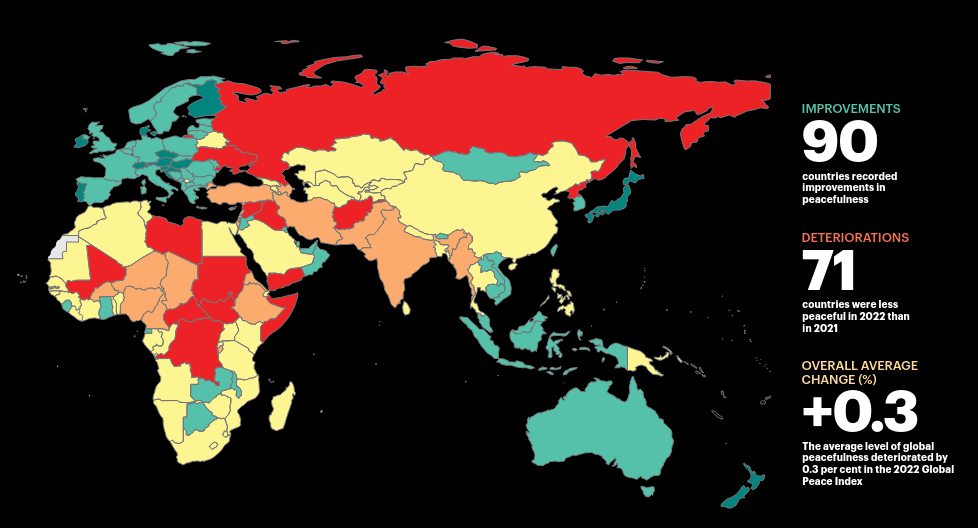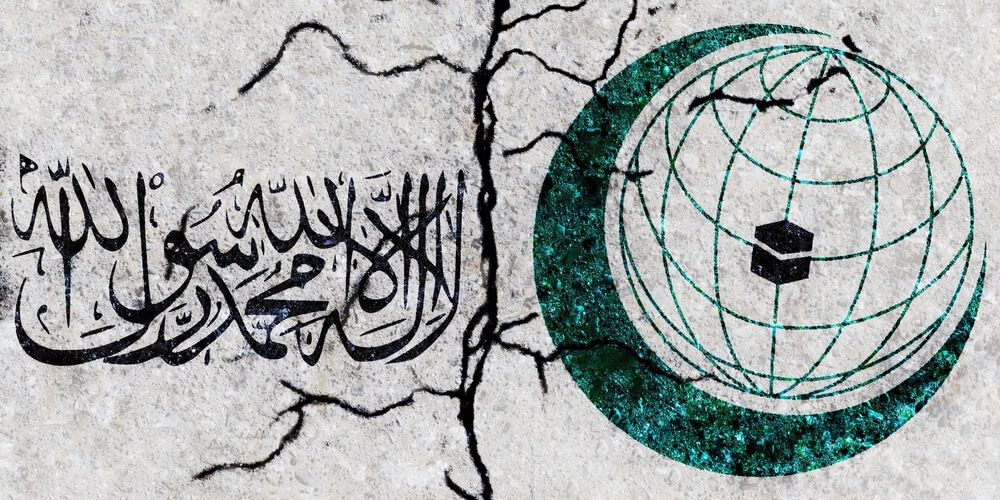OIC countries have a middling to low ‘state of peace’
Eight OIC countries are in the ‘high’ state of peace category, 21 in the medium category, 11 in the low category and eight are the least peaceful worldwide.
Peacefulness has declined to its to lowest level in 15 years fuelled by post-COVID-19 economic uncertainty and the Ukraine conflict, according to the the 16th edition of the Global Peace Index from the Institute for Economics & Peace (IEP).
Out of the 163 countries ranked, 48 out of the 57 member countries of the Organisation of Islamic Council (OIC) were included. No OIC countries featured in the top 15 slots, the ‘very high’ state of peace. Eight OIC countries were in the ‘high’ state of peace category, 21 in the ‘medium’ category, 11 in the low category, and eight in the ‘very low’ category.
Iceland remains the most peaceful country worldwide, a position it has held since 2008. New Zealand, Ireland, Denmark and Austria also top the Index. For the fifth consecutive year, Afghanistan is the least peaceful country, followed by Yemen, Syria, Russia and South Sudan. Out of the 14 countries in the very low peace category, eight are in the OIC.
Seven of the 10 countries at the top of the Index are in Europe, with Turkey the only country in the region to be ranked outside the top half of the Index.
Malaysia topped the list for OIC countries in the ‘high’ state of peace category, in 18th place, followed by Qatar in 23rd place (up six places on the previous Index), Kuwait at 39 (down one place), Albania at 41, Indonesia at 47 (down two places), Jordan at 57 (up 15 places), the UAE at 60 (up one place).
Most OIC countries were in the the medium category. Senegal dropped 12 places to 70, Kosovo rose 8 places to 71, Morocco rose 9 places to 74, Gabon was ranked 75, and Tunisia dropped three places to 85. Tanzania was ranked 85, Uzbekistan 86 (up 7 places), Kyrgyzstan 91 (down 21), and Tajikistan to 92 (up six places). Bangladesh was 96 (up 6 places), Kazakhstan was ranked 97 (down 29), and Bahrain came 99th. Turkmenistan was at 104, Guyana at 107, Cote d’Ivoire at 108, Algeria 109, Mauritania at 112, and Djibouti at 113. Saudi Arabia was ranked 119, up 8 places, Uganda 121, and Egypt at 126 (up five places).
In the ‘low’ category, Azerbaijan was ranked 128, Palestine 133, Chad 136, Lebanon 138, Niger 140, Iran 141, Cameroon 142, Nigeria 143, Turkey 145 (up five places), Burkina Faso 146 (down 12 places), and Pakistan at 147 (up one place).
In the ‘very low’ category – the least peaceful - Mali was ranked 150, Libya 151, Sudan 154, Somalia 156, Iraq 157, Syria 161, Yemen 162, and Afghanistan at 163.

Dark green ‘very high’ state of peace, green ‘high’, yellow ‘medium’, orange ‘low’, red ‘very low’ (Global Peace Index 2022).
The Index’s measure of global peacefulness showed a deterioration of 0.3% in 2021, the eleventh deterioration in peacefulness in the last 14 years. Ninety countries improved, and 71 deteriorated, which the reported said highlighted “that countries deteriorate much faster than they improve”.
The global economic impact of violence was $16.5 trillion in 2021, equivalent to 10.9% of global GDP, or $2,117 per person. For the 10 countries most affected by violence, the average economic impact was equivalent to 34% of GDP, compared to 3.6% in the countries least affected.
On the positive side, terrorism attacks declined, with 70 countries recording no attacks in 2021, the best result since 2008. Twenty-eight countries have high levels of instability, and 10 countries recorded the worst possible political terror score.
Nonetheless, the political terror scale, political insecurity, neighbouring country relations, refugees and internally-displaced-persons (IDPs) reached their worst score since the inception of the Index.
However, inflation, which has increased food insecurity, and political instability is having a negative impact, with Africa, South Asia and the Middle East under the greatest threat, the report notes.
The global inequality in peacefulness has continued to increase. Since 2008, the 25 least peaceful countries deteriorated on average by 16%, while the 25 most peaceful countries improved by 5.1%. Since 2008, 116 countries reduced their homicide rate.
“Last year we warned about the economic fallout from COVID-19. We are now experiencing supply chain shortages, rising inflation, and food insecurity that have been compounded by the tragic events in Ukraine. The political and economic consequences of this will reverberate for years to come. When combined with the record poor scores for neighbouring relations, political insecurity and intensity of internal conflict, governments, organisations, and leaders must harness the power of peace,” said Steve Killelea, Founder & Executive Chairman of IEP, to the press.
“The economic value of lost peace reached record levels in 2021. There is a need to reverse this trend, and the Index has shown that those countries that implement the attitudes, institutions and structures that create and sustain peaceful societies, witness an improved economic outcome,” he added.
The intensity of violent demonstrations has increased by 49% since 2008, with 126 of the 163 countries in the Index deteriorating. The report stated that this is a global trend, affecting all regions of the world except the Middle East and North Africa.
South Asia has the highest frequency and intensity of violent demonstrations by region, with India, Sri Lanka, Bangladesh, and Pakistan recording their highest levels since the first index. In Europe, there were widespread anti-lockdown protests, especially in Belgium, France, the Netherlands, Austria, Croatia and the UK, with similar developments in North America, according to the report.
